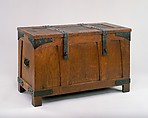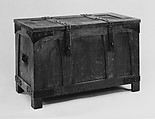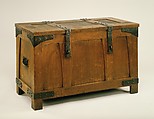Chest
Gustav Stickley American
In 1899, Gustav Stickley, a leading designer and proselytizer of the American Arts and Crafts movement, founded the Craftsman Workshops (called United Crafts before 1904) to manufacture his line of Craftsman furniture. Simply designed for ease of manufacture, Craftsman furniture was modestly priced to appeal to the average American. Typical of early Stickley furniture, the design of this cedar-lined oak chest depends on the frank expression of the structural framework and panels, with sturdy iron hardware as its only embellishment. A line drawing of this design was published as early as 1901 in Stickley’s sales catalogue called "Chips from the Workshops of the Gustave [sic] Stickley, Syracuse, N. Y., U.S.A." The chest, which bears a decal with an early Stickley mark used in 1902 and 1903, was made for use in Stickley's home on Columbus Street in Syracuse, New York, where he lived from 1900 until 1911. According to Stickley’s grandson, Ben Wiles, Jr., to whom the chest descended, it was part of Stickley’s redecoration of the Syracuse house following a fire that took place on Christmas Eve in 1902. He remembered that the chest, placed on the second floor of the house in a space between the main stairway and the sewing room, was used to store linens, blankets, and, occasionally, silver.
Due to rights restrictions, this image cannot be enlarged, viewed at full screen, or downloaded.
This artwork is meant to be viewed from right to left. Scroll left to view more.




